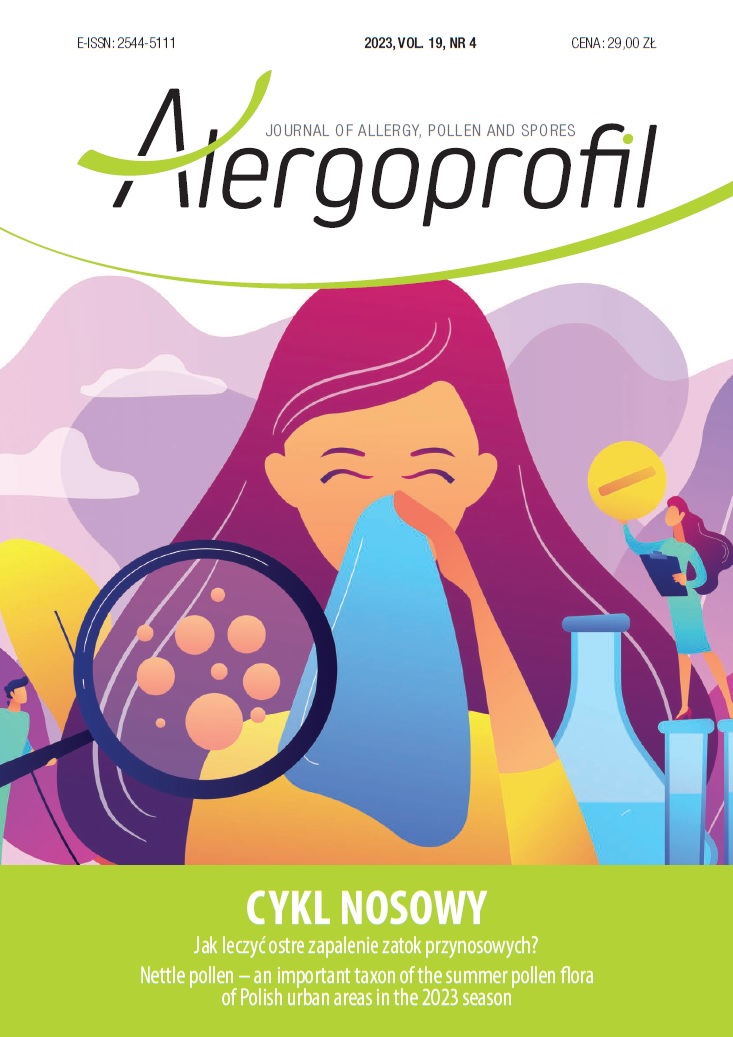Nasal cycle Review article
Main Article Content
Abstract
The nasal cycle is a physiological phenomenon that may cause a periodic change in the patency of the nasal cavities through changes in congestion and constriction of the nasal mucosa especially in the inferior nasal turbinates. This phenomenon was first described by the German physician Richard Kayser in 1895. The nasal cycle is regulated by the hypothalamus via the sympathetic nervous system. Air flow through the nasal cavities is influenced by different factors such as hyperventilation, changes in body position, air temperature, nasal diseases, infection, allergy and vasomotor rhinitis, as well as medications like acetylsalicylic acid and sympathomimetics.
Downloads
Article Details

This work is licensed under a Creative Commons Attribution-NonCommercial-NoDerivatives 4.0 International License.
Copyright: © Medical Education sp. z o.o. This is an Open Access article distributed under the terms of the Attribution-NonCommercial 4.0 International (CC BY-NC 4.0). License (https://creativecommons.org/licenses/by-nc/4.0/), allowing third parties to copy and redistribute the material in any medium or format and to remix, transform, and build upon the material, provided the original work is properly cited and states its license.
Address reprint requests to: Medical Education, Marcin Kuźma (marcin.kuzma@mededu.pl)
References
2. Kahana-Zweig R, Geva-Sagiv M, Weissbrod A et al. Measuring and Characterizing the Human Nasal Cycle. PLoS One. 2016; 11(10): e0162918. http://doi.org/10.1371/journal.pone.0162918.
3. Kumaran EM. Alteration in Nasal Cycle Rhythm as an Index of the Diseased Condition. In: Pathophysiology – Altered Physiological States. InTech; 2018. http://doi.org/10.5772/intechopen.70599.
4. Asakura K, Hoki K, Kataura A et al. Spontaneous Nasal Oscillations in Dog: A Mucosal Expression of the Respiration- related Activities of Cervical Sympathetic Nerve. Acta Otolaryngol. 1987; 104(5-6): 533-38. http://doi.org/10.3109/00016488709128285.
5. Ishii J, Ishii T, Ito M. The Nasal Cycle in Patients with Autonomic Nervous Disturbance. Acta Otolaryngol. 1993; 113(suppl. 506): 51-6. http://doi.org/10.3109/00016489309130241.
6. Mainland J, Sobel N. The Sniff Is Part of the Olfactory Percept. Chem Senses. 2006; 31(2): 181-96. http://doi.org/10.1093/chemse/bjj012.
7. Scott JW, Sherrill L, Jiang J et al. Tuning to Odor Solubility and Sorption Pattern in Olfactory Epithelial Responses. J Neurosci. 2014; 34(6): 2025-36. http://doi.org/10.1523/JNEUROSCI.3736-13.2014.
8. Williams MR, Eccles R. The nasal cycle and age. Acta Otolaryngol. 2015; 135(8): 831-4. http://doi.org/10.3109/00016489.2015.1028592.
9. Raghuraj P, Telles S. Immediate Effect of Specific Nostril Manipulating Yoga Breathing Practices on Autonomic and Respiratory Variables. Appl Psychophysiol Biofeedback. 2008; 33(2): 65-75. http://doi.org/10.1007/s10484-008-9055-0.
10.Kotan D, Tatar A, Aygul R et al. Assessment of nasal parameters in determination of olfactory dysfunction in Parkinson’s disease. J Int Med Res. 2013; 41(2): 334-9. http://doi.org/10.1177/0300060513476433.
11. White DE, Bartley J, Nates RJ. Model demonstrates functional purpose of the nasal cycle. Biomed Eng Online. 2015; 14(1): 38. http://doi.org/10.1186/s12938-015-0034-4.
12. Soane RJ, Carney AS, Jones NS et al. The effect of the nasal cycle on mucociliary clearance. Clin Otolaryngol Allied Sci. 2001; 26(1): 9-15. http://doi.org/10.1046/j.1365-2273.2001.00423.x.
13. Eccles RB. The nasal cycle in respiratory defence. Acta Otorhinolaryngol Belg. 2000; 54(3): 281-6.
14. Tatar A, Altas E. Nasal Cycle Pattern Can Transform Into Another Form Over Time. Electron J Gen Med. 2014; 11(1): 1-5. http://doi.org/10.15197/sabad.1.11.01.
15. Pendolino AL, Scarpa B, Ottaviano G. Relationship Between Nasal Cycle, Nasal Symptoms and Nasal Cytology. Am J Rhinol Allergy. 2019; 33(6): 644-9. http://doi.org/10.1177/1945892419858582.
16. Gotlib T, Samoliński B, Grzanka A. Effect of the nasal cycle on congestive response during bilateral nasal allergen provocation. Ann Agric Environ Med. 2014; 21(2): 290-3. http://doi.org/10.5604/1232-1966.1108593.

